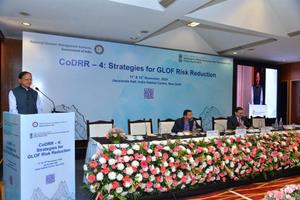
PM Modi’S Principal Secretary Highlights Mitigating Risks Associated With Glacial Lakes
“The discussions on Sikkim glacial lake outburst flood disaster has brought to focus the enormity of the challenge. Indeed, the South Lhonak GLOF was a wake-up call for all of us. He underscored the urgent need for effective strategies to address risks associated with glacial lakes,” said Mishra while speaking on the occasion of 4th Workshop of the Committee on Disaster Risk Reduction (CoDRR) on Strategies for GLOF (Glacial Lake Outburst Flood) Risk Reduction.
He focused on international perspectives and experiences, pertinently India's experiences, gaps and challenges in mitigating the risks and related aspects while complimenting the National Disaster Management Authority (NDMA) and the Department of Water Resources for organising the workshop.
Quoting PM Modi, he said,“Disaster risk reduction is not just about responding to disasters but also about building resilience.”
Mishra reiterated PM Modi's emphasis that“the best way to deal with disasters is to prevent them,” reminding us that proactive measures are essential in safeguarding our communities.
Furthermore, he stated,“We must work together across borders and disciplines to create a safer world,” highlighting the importance of collaboration in addressing global challenges like GLOF risks.
On the International Cooperation side, Mishra emphasised that India's commitment extends beyond national borders; hence the vital aspect of engaging with GLOF experts from countries such as Bhutan, Nepal, Peru, Switzerland and Tajikistan. He iterated that such collaboration is vital to enhancing our understanding of response strategies.
Mishra underlined the key contributions of experts from the country and abroad, who have enriched our understanding of the critical issues.
Structuring his deliberation, Mishra mentioned the challenges including the confusion over the quantum of the problem defined in terms of the number of glacial lakes and their risk factors.
He said that earlier attempts to mitigate risks from the South Lhonak Lake were not successful and plans were primarily restricted to scientific hazard assessments and geospatial monitoring of lake size increases, while there was diffused responsibility among states and central agencies, causing confusion regarding roles.
In response to these challenges, Dr Mishra stressed that the Government of India initiated a coordinating platform named the Committee on Disaster Risk Reduction (CoDRR).
He added that this platform has enabled us to host a series of meetings followed by regular feedback; renewed communication between central scientific agencies and states on this critical subject; and clearly delegate primary responsibility to states, while ensuring adequate support from central agencies.
He expressed positivity through this trifocal lens - assessment, monitoring, and mitigation - India has made substantial progress.
Mishra said our coordinated efforts have resulted in the compilation of a dynamic list of approximately 200 high-risk glacial lakes from a total of 7,500 surveyed.
He further added that this iterative process has allowed us to categorize these lakes based on risk levels effectively. He mentioned that States were encouraged to conduct expeditions to assess all A-category lakes in the summer of 2024, leading to significant engagement from local authorities.
Mishra particularly mentioned about Sikkim teams, who visited 18 out of 40 designated lakes with representation from various agencies such as CWC, GSI, CDAC, Army, ITBP, and local academic institutions.
He said that the plans for mitigation measures have been initiated at five lakes in Sikkim. This will be backed by the Government of India's approval for the National GLOF Risk Mitigation Programme with an allocation of ₹150 crores for four states.
Looking ahead, Mishra suggested that States and Union Territories must continue to lead monitoring and mitigation efforts concerning glaciers and glacial lakes, with sustained support from central scientific institutions.
He said that strengthening State Disaster Management Authorities (SDMAs) will be vital in enhancing our capacity to respond effectively.
Highlighting the need to think of innovative ways to have a dedicated financial window for GLOF risk reduction across these affected states and UTs, he mentioned that this initiative would contribute to safeguarding our water security because the health of our glaciers is indeed at the heart of it.
Present on the occasion were dignitaries including Members of the National Disaster Management Authority (NDMA) among other eminent panelists and speakers attending the program.

Legal Disclaimer:
MENAFN provides the
information “as is” without warranty of any kind. We do not accept
any responsibility or liability for the accuracy, content, images,
videos, licenses, completeness, legality, or reliability of the information
contained in this article. If you have any complaints or copyright
issues related to this article, kindly contact the provider above.


















Comments
No comment